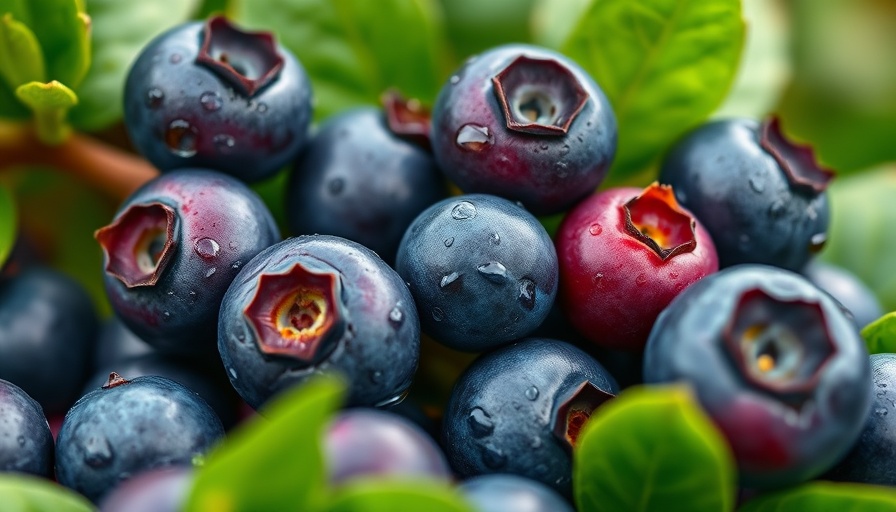
Discover the Joy of Homegrown Blueberries
Growing your own blueberries can be a rewarding endeavor that not only provides delicious fruit but also enhances your garden’s aesthetic appeal. Whether you’re enjoying fresh blueberries on pancakes, mixing them into yogurt, or whipping up a batch of homemade jam, nothing beats the taste of berries you’ve nurtured yourself. Let's explore the top varieties that thrive in various climates and how you can successfully add these vibrant fruits to your garden.
Why Grow Blueberries?
Blueberries are not only tasty but also packed with antioxidants, vitamins, and minerals that contribute to a healthy diet. They are relatively easy to care for, making them a great choice for both novice and experienced gardeners. Furthermore, their colorful blooms and foliage mean that they can enhance the visual appeal of your garden throughout the seasons. This sustainable practice promotes healthy eating while giving you a sense of accomplishment every time you harvest your berries.
Top Picks for Blueberry Varieties
Here are my favorite blueberry varieties that grow exceptionally well in diverse environments:
1. Biloxi - The Low-Chill Wonder
Perfect for southern climates, the Biloxi blueberry is a Southern highbush type developed for regions with low chill hours, making it an ideal selection if you live in warmer areas. This variety produces medium-sized berries and can even thrive in areas with fewer chilly nights.
2. Bluecrop - The Crowd-Pleaser
Probably the most famous blueberry variety worldwide, Bluecrop is a versatile Northern highbush type. It flourishes under a range of climatic conditions and is known for its outstanding flavor and disease resistance. With beautiful changing foliage, it remains an attractive addition to any home garden.
3. Blueray - A Flavored Favorite
This mid-season variety boasts large, flavorful berries and a robust growth habit. The Blueray blueberry is celebrated for its excellent taste, making it a fantastic pick for berry lovers looking to enjoy the sweetest homegrown fruit.
4. Brightwell - Garden and Health All-in-One
Brightwell blueberries yield a significant harvest of medium-sized, sweet berries while displaying beautiful ornamental qualities. This variety is ideal for those seeking a productive plant that also looks great in their landscape.
5. Pink Icing - Beauty Meets Taste
Known for its striking pink fruit and delicate blooms, Pink Icing blueberries not only taste great but also provide a unique aesthetic. This variety is perfect for container gardening, allowing you to enjoy homegrown goodness in even the smallest outdoor spaces.
Practical Tips for Growing Blueberries
When planting blueberries, consider the following:
- Soil Type: Blueberries thrive in acidic, well-draining soil. Amend your garden's soil with organic materials such as pine mulch to achieve the right pH balance.
- Sunlight: Ensure your blueberries receive plenty of sun; ideally, aim for at least 6-8 hours a day.
- Watering: Keep the soil consistently moist but not waterlogged. Irrigation is key, especially during dry spells to prevent the plants from drying out.
- Container Gardening: If space is limited, many dwarf varieties are suitable for pots, making it easy to grow blueberries even on a patio or balcony.
Future Trends in Blueberry Cultivation
The popularity of blueberries continues to rise as more people discover their multifaceted benefits, from delicious taste to health advantages. Expect to see innovations in blueberry plant development, such as varieties specifically bred for urban environments or those with enhanced disease and pest resistance.
Embrace the Blueberry Journey
For those thinking of starting their own blueberry patch, now is an excellent time to learn everything you can about these delightful plants. Not only do they produce nutritious fruit, but they also bring vibrant color and life to your outdoor space. By selecting the right varieties and providing proper care, you'll be well on your way to enjoying your first homegrown harvest.
Call to Action: Start your blueberry-growing journey today! Visit your local gardening center or explore online nurseries to find the best varieties suited to your climate and gardening style.
 Add Row
Add Row  Add
Add 




Write A Comment